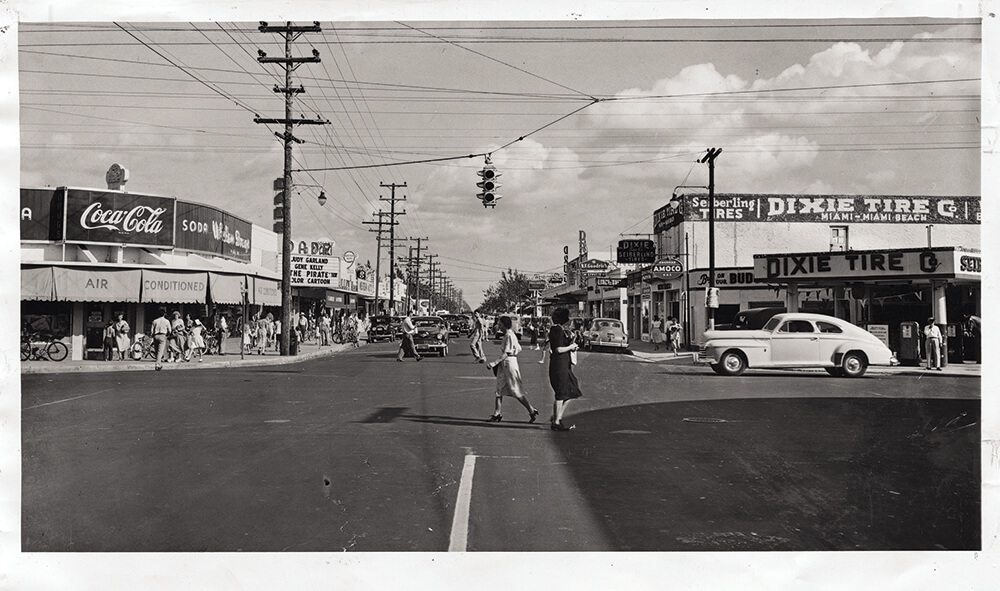Allastyle
Allapattah: A History
Words by Paul S. George, Ph.D.

As Miami’s center city neighborhoods go,
Allapattah has been, until recently, largely
overlooked by investors who have otherwise
invested heavily in other bustling areas like
Wynwood, Design District, Brickell, and Little
Havana.
This is not the case today, however,
as this community, ideally located and
informally defined by borders stretching from
Northwest 7th to Northwest 27th Avenue, and
from S.R. 112 to the Miami River, is seeing
significant new investment and development
in several quarters.
The name “Allapattah” is said to be a Native
American term for Alligator or Crocodile.
Clearly, Allapattah rests in a place, on the
north bank of the Miami River, where these
reptiles roamed.
Limited development in Allapattah followed
the entry of oil and railroad baron Henry
M. Flagler’s railroad into Miami in 1896,
which birthed, in the same year, the City
of Miami; two years later, Flagler built a
9-hole golf course, on N.W. 11 Street near
N.W. 12th Avenue. A dozen years later, in
1910, Highland Park, one of the young City
of Miami’s first suburbs, opened on the west
side of today’s Northwest 7th Avenue and
11th Street amid much hoopla. Soon after,
on the city’s 15th birthday in July 1911,
astonished Miamians and visitors witnessed
an aerial exhibition by Howard Gill in a
Wright Brothers’ airplane flying over the
Flagler golf course.

The great real estate boom of the mid1920s led to a radical transformation of
Miami; nowhere, perhaps, was its impact
more far-ranging than in Allapattah. With
the Boom, which peaked in 1925, Allapattah
witnessed the creation of numerous
residential subdivisions while a rising
retail and institutional center emerged on
Northwest 36th Street and along Northwest
17th Avenue. One of the county’s oldest high
schools, Andrew Jackson High, today’s Miami
Jackson High School, opened, as did other
schools and houses of worship.

HISTORIC BUSINESSES
Merrill Stevens Boatyard, still in business
more than almost 100 years later. Other
Allapattah maritime businesses of that era
included Lou Nuta’s boatyard, the preferred
businesses for rumrunners since it outfitted
their vessels with Liberty Aircraft engines,
allowing them to power past Coast Guard and
other police vessels attempting to apprehend
them and their contraband cargo. The Ebsary
family and their eponymous foundation
company, standing a few blocks west of
Nuta’s boatyard on the north bank of the
stream, were pioneers in marine construction
and the laying of deep foundations. It remains
an active business nearly one hundred years
after its inception.
THE EVENTFUL DEPRESSION YEARS
THE IMPACT OF ADDITIONAL TRANSIT CONNECTIONS
THE CONTINUING DEVELOPMENT OF THE HEALTH DISTRICT
A CIVIC CENTER AND MORE
On the site of the old Miami Country Club, a Miami
mainstay since the 1920s, arose in the second half of
the 1950s an expansive civic center with governmental
offices at the municipal, county, and state levels. As
it developed, the center came to include a facility for
the Sheriff’s Department, the Richard Gerstein Justice
Building, the Miami Police Department, Cedars of
Lebanon Hospital (today’s U-Health), and, by 1968, the
Veterans Administration Hospital. Suddenly, a quiescent
area without a main north-south street running through
it, was transformed into a bustling beehive of activity.
The Civic Center and Health District represent the
busiest areas of Allapattah, but other quarters also
resonate with activity and importance. As noted,
Northwest Seventeenth Avenue and Northwest
Thirty-Sixth Street were the earliest, most important
commercial, professional and institutional streets, and
they have remained important in the final decades of
the twentieth century and beyond. In the meantime,
Northwest Twentieth Street, in the same era, rose in
importance with emergence of a mile-long discount
clothing district. Just north of the street stands the right
of way of the Florida East Coast Railway’s extension,
which led to the emergence of an industrial district on
the edge of it.

ADDITIONAL CHANGES
The Farmers’ Market, which has been a fixture in Allapattah since the mid-1930s,
has, in recent times, found itself in the sights of developers, one of whom is Robert
Wennett, the builder of the iconic Lincoln Road parking garage, located at its
western edge. Wennett purchased the ten acre market for $16 million in 2016 ,
with plans to build an elaborate mixed use complex, part of which will rise above
the sheds of the old market. Wennett hired Bjarke Ingels, the Danish “starchitect,”
to design the new complex. The market, however, remains active with forty
retailers and wholesalers operating there in 2019.
In recent years, the stunning success of nearby Wynwood has spilled over onto
the eastern flank of Allapattah with the opening of another iteration of the popular
Wood bar from the latter neighborhood. Wall art, which propelled Wynwood to
international fame, began to appear in that area, too.